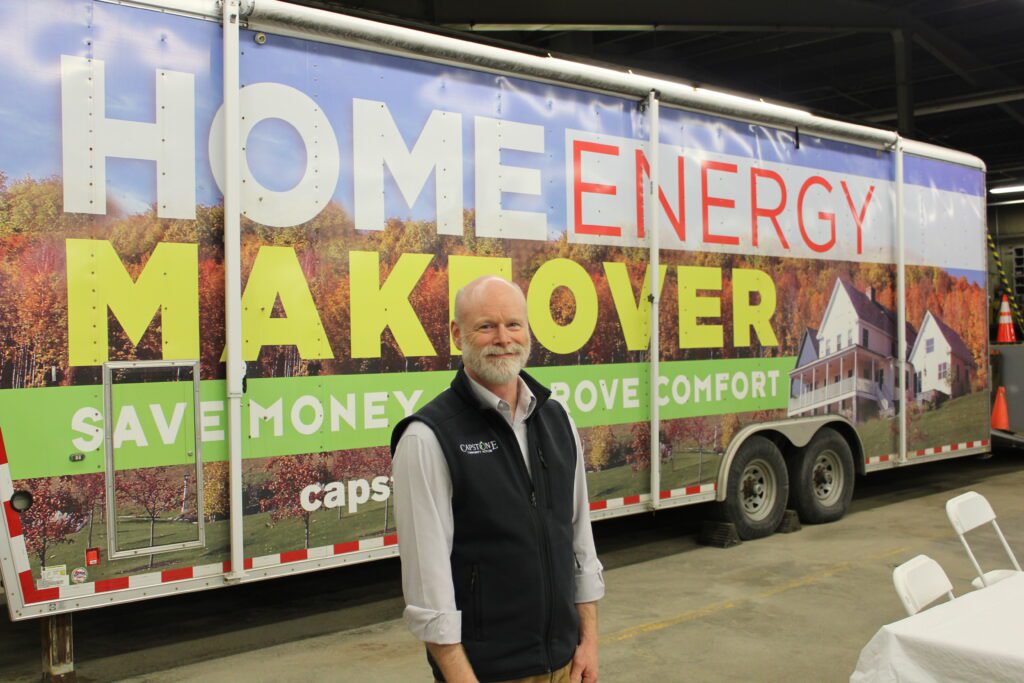
Paul Zabriskie, Capstone’s Director of Weatherization and Climate Impact
Recently, Vermont announced the arrival of $7.9 million in American Recovery Plan Act (ARPA) funds earmarked for weatherization assistance programs. “What that means, in the near term,” said Paul Zabriskie, Director of Weatherization and Climate Impact at Capstone, “is we’re able to really step up the pace of weatherization.”
Capstone is the community action agency serving much of central Vermont. Weatherization is one of its signature programs, which it pitches as a way to “save money and the planet.” In other words, when it’s 10 below and you live in a drafty home, your budget forces you to choose between buying food and staying warm, and when the fuel you burn goes straight out through leaky doors and roofs—weatherization can effectively reduce your bills, reduce emissions, and create a more comfortable, healthier home environment for you and your family.
But if actually getting the work done sounds like a series of obstacles, it doesn’t have to be. Capstone provides wraparound services to income-eligible Vermonters, including the home audit, labor, and materials. It’s professional work done for free. Renters with receptive landlords may also take advantage of Capstone’s weatherization offerings.
“We’re well equipped with the tools that allow this to be a relatively fast process. The average job takes two to three days,” said Zabriskie. While those two to three days are somewhat invasive, he says, the work is generally done in places residents don’t usually go, like crawl spaces, attics, and knee walls. The result is, Zabriskie said, that weatherization clients “don’t see the change: they feel the change, whether they feel it in their wallet or by not having their feet freeze when standing at the kitchen sink.”
For Capstone, this marks a deepening commitment to building resilience and advancing economic and environmental justice. For approximately 15 years, Zabriskie said, Capstone has been in both grant-funded and fee-for-construction marketplaces: whether those receiving weatherization work pay out of pocket or have their costs covered by grants has depended on their income eligibility. Now, Capstone is using the influx of federal funding to hone in on its mission, Zabriskie said, and put resources toward free weatherization. Vermonters whose income places them above the qualifying threshold for Capstone’s program should contact Efficiency Vermont. “There are ARPA resources that are directed to all of the marketplaces. Capstone is implementing funding targeted to income-eligible Vermonters. Efficiency Vermont is managing the resources that are available to everyone else,” Zabriskie explained.
There is an urgency to Capstone’s weatherization work: to help Vermont families, to reduce heating emissions—home heating is one of our state’s greatest greenhouse gas producers, after transportation—and to spend down time-sensitive ARPA funds. Besides the sheer quantity, ARPA funds have some flexibility built in. “They allow us to take on some additional challenges when we run into them. There’s a piece where we can help with home repairs. We can help share the cost of vermiculite removal, or we can use them to, say, potentially install a heat pump, or pellet stoves, or upgrade woodstoves to clean, twenty-first century woodstoves,” explained Zabriskie.
When it comes to replacing devices, WEC offers many incentives to members through its Button Up program. Stacked with opportunities available with ARPA weatherization funds, eligible members can replace essential home appliances at considerable savings—or for free.
As speedy as the Capstone professionals are, eligible members who call now will still go on a waiting list. Capstone prioritizes greatest need first, and while they work on weatherization year-round, what Zabriskie calls a “seasonal awareness” to the work means there’s an influx of calls when it gets chilly. But don’t let that deter you. Call today to take advantage of new funding, and enjoy greater comfort and lower bills all year.
What are the benefits of weatherizing?
“The opportunity for Co-op members is to get work done that produces real pocketbook savings in terms of reducing the amount of energy they need,” said Paul Zabriskie of Capstone.
Energy includes fuel—and it also includes labor. Members who heat with wood might need a cord less after weatherizing. That saves a lot of stacking time.
Weatherizing leads to:
- Lower fuel costs
- Healthier air quality
- Greater indoor comfort
- Reduced stratification (the top floor extremely hot in summer/cold in winter)
- Reduced drafts
- Moisture control, which impacts durability
- Lower carbon emissions
“It depends, how you value any one of these benefits,” said Zabriskie, “but you win on all of them.”
To reach Capstone: capstonevt.org/weatherization / 802-479-1053 / 1-800-639-1053
For WEC incentives: call the Energy Coach at 802-224-2329 or visit wec.coop/energy-coach-home
For income eligibility guidelines, view the chart below or visit capstonevt.org.
Are you income-eligible?
Number of persons in your household and maximum household income:
1: $47,110.00
2: $53,840.00
3: $60,570.00
4: $67,300.00
5: $72,684.00
6: $78,068.00
7: $83,452.00
8: $88,836.00
